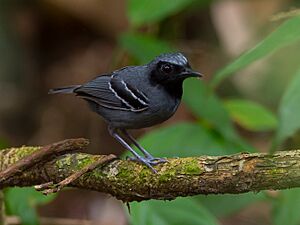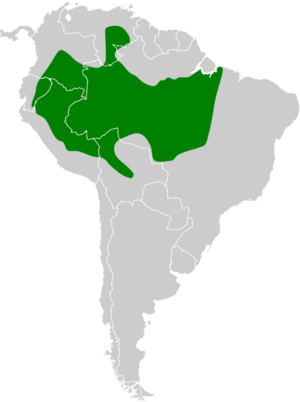Black-faced antbird facts for kids
Quick facts for kids Black-faced antbird |
|
|---|---|
 |
|
| Male | |
| Conservation status | |
| Scientific classification | |
| Genus: |
Myrmoborus
|
| Species: |
myotherinus
|
 |
|
The black-faced antbird (Myrmoborus myotherinus) is a small bird, about 12–13 cm (5 inches) long. It belongs to the antbird family, called Thamnophilidae. You can find this bird across a large area of the Amazon basin. It loves to eat insects and spiders. Sometimes, it even follows groups of army ants to catch bugs that the ants scare out of hiding!
Contents
What's in a Name? (Taxonomy)
The black-faced antbird was first described in 1825 by a German scientist named Johann Baptist von Spix. He gave it the scientific name Thamnophilus myotherinus. The second part of its name, myotherinus, comes from an old Greek word meaning "flyhunter." This is a perfect name for a bird that loves to hunt insects!
Scientists currently recognize seven different types, or subspecies, of the black-faced antbird. More research is being done to see if some of these might actually be separate species.
What Does It Look Like? (Description)
The black-faced antbird is about 12–13 cm (4.7–5.1 in) long. It weighs around 16–22 g (0.56–0.78 oz), which is about as much as a few quarters.
- Males: The male birds are bluish-grey on top. Their wings and tail are a bit darker. They have a black face, throat, and black tips on their wings.
- Females: Females are usually duller. They are mostly olive-brown with black-tipped wings. Their undersides are a light, creamy color.
The different subspecies can look a bit different. Males might be darker, and females can have different colors or patterns.
Where Does It Live? (Distribution and Habitat)
The black-faced antbird lives in a huge area of about 4.8 million square kilometers. This covers parts of the Amazon basin in countries like Bolivia, Brazil, Colombia, Ecuador, Peru, and Venezuela.
It prefers to live in tropical forests that are always green. These are usually found below 1000 meters in elevation. It especially likes areas with thick plants, like where trees have fallen, creating open spaces in the forest.
How Does It Live? (Behaviour)
Building a Home (Breeding)
Scientists first described the nest of the black-faced antbird in 2003. They found two nests in Manú National Park in Peru.
- The Nest: These nests were shaped like a dome or an oven. They were built on the ground, hidden among thin branches. Each nest had four layers! The inside layer was made of soft palm fibers. Then came a layer of dry leaves, followed by a strong layer of flexible vine stems. The outside was covered with more dry leaves, making the nest very hard to spot.
- Eggs and Chicks: One nest had a single egg, and the other had two. The eggs were white with small dark purple spots and streaks. They were about 20 mm × 14 mm (0.79 in × 0.55 in) or 21 mm × 16 mm (0.83 in × 0.63 in) in size.
- Parent Care: Both the mother and father bird helped build the nest. They also took turns sitting on the eggs to keep them warm. Once the chicks hatched, both parents worked together to feed them. If a predator came near the nest, one parent would pretend to have a broken wing. This trick would distract the predator away from the nest and keep the babies safe!
What's for Dinner? (Food and Feeding)
The black-faced antbird mostly eats insects and spiders. It usually travels in pairs or small family groups. They often join up with other bird species to hunt together.
This bird moves carefully, hopping forward and sometimes flapping its wings. Then it pauses to look for prey. It often follows swarms of army ants. As the ants march, they disturb insects, making them easier for the antbird to catch. However, the black-faced antbird doesn't have to follow army ants to find food. When other birds that always follow ants are not around, the black-faced antbird becomes the boss over other species at the ant swarm.
Is It Safe? (Status)
Scientists don't know exactly how many black-faced antbirds there are, or if their numbers are changing. However, they believe the species is not in danger. Because of this, the black-faced antbird is listed as "Least Concern" on the IUCN Red List of Threatened Species. This means it's not currently considered threatened.


